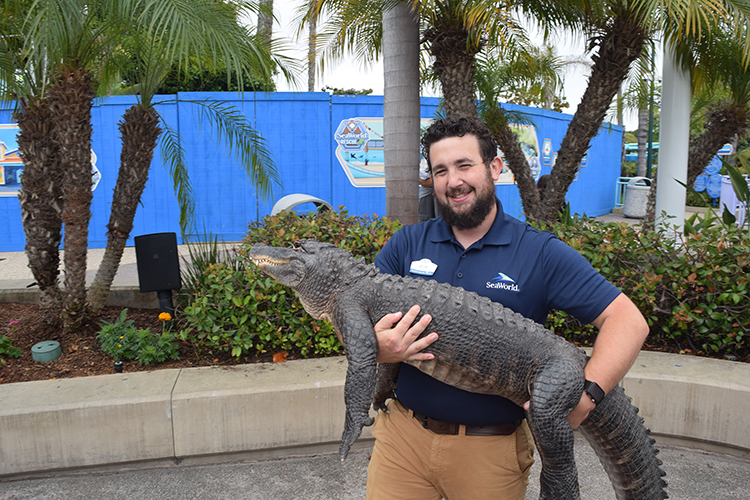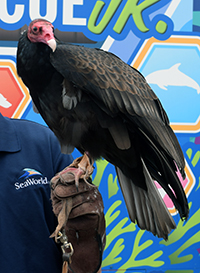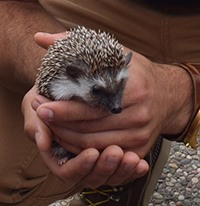
By Donald H. Harrison

SAN DIEGO – SeaWorld’s new Rescue Jr. area mixes playtime for young children and personal encounters with such rescued animals as an alligator, a turkey vulture, and an African hedgehog.
For opportunities for children to pet such animals, under close supervision, SeaWorld contracted with Wild Things Inc., a rescue center in Weimar, California, that was founded in 1988 and still is operated by a Jewish family – the Kerschners.
Joseph (JoJo) Kerschner heads a three-member team at SeaWorld that interacts with children and their parents, answering their many questions about the animals that they are permitted to touch.

Windsor, the turkey vulture, was rescued after someone shot him in the wing, disabling him from sustained flight.

Elvis, the hedgehog, has three thousand to five thousand spines all over his back, and he can blend in with the grasslands of his natural habitat. One of his defense mechanisms is to eat scorpions and then spread his saliva over his body, to give himself an unpleasant smell, discouraging possible predators. Illegal to own privately in California because it is considered an invasive species, he was seized from would-be pet smugglers as they crossed into the state from Mexico.
Spike, the alligator, was discovered 32 years ago in Los Angeles in someone’s bathtub. If an alligator is discovered in the wild, and in need of rescue because of an injury, it is released back to the wild after being nursed to health. However, in the case of alligators found illegally in domestic settings, they are taken to live permanently at rescue centers because the circumstances of their breeding are unknown. Alligators that are in-bred by unscrupulous breeders may carry defective genes that should not be released into the wild alligator gene pool, Kerschner explained.
My grandson Brian, 14, and I interviewed Kerschner on Sunday, June 4, while another grandson, Shor, 22, photographed the showcased animals at the Rescue Jr. complex.
Wild Things Inc. is located approximately 45 miles northeast of Sacramento on land purchased many years ago by JoJo’s grandfather, educator Lee R. Kerschner, Ph.D., who, among other distinctions, served as executive director of the California Commission for the Review of the Master Plan for Higher Education. JoJo’s father, Gabriel, founded Wild Things Inc. on the family’s spread of land, and JoJo grew up caring for and later lecturing about the animals.
“As I was growing up, I was always part of the school programs,” JoJo Kerschner said. “As I got older, we started to shift that a little bit.” His father “started sending me on bigger jobs and that is how I ended up down here.”
Kerschner and his animals first started interacting with guests in 2020 “right at the start of COVID. I had to wear masks on stage, I remember.” At the time, Sesame Street characters appeared in SeaWorld’s “R is for Rescue” program which “had Sesame Street characters on stage and we made what were almost like guest appearances in their show. They were talking about wildlife rescue so Elmo would introduce our animals and we would come out and give a speech about those rescued wildlife.”
Since that time SeaWorld’s corporate parents have developed Sesame Place, a theme park in Chula Vista that integrated the former Aquatica San Diego park with a Sesame Street makeover. That required a re-design at the SeaWorld in Mission Bay, leading to the Rescue Jr. area that in addition to opportunities to meet live animals includes a splash pad, water features, climbing structures, rides, an obstacle course, fun animal facts and a display of real animal rescue vehicles, according to SeaWorld media representative Tracy Spahr. In addition to Wild Things Inc., SeaWorld invites representatives of other organizations, such as the American Society for the Prevention of Cruelty to Animals, to make onsite presentations to guests.
Kerschner said Wild Things Inc. deals primarily in two classes of animal rescues: Injured animals, such as Windsor the turkey vulture, and animals illegally kept as pets such as Spike the alligator and Elvis the hedgehog. The Wild Things menagerie, kept in a non-public area of Sea World, also includes a great horned owl, a California desert tortoise, and an African crested porcupine, among others.
He said that Wild Things Inc. and its partner organization, Conservation Ambassadors Inc. in Paso Robles, have approximately 200 rescue animals between them, but “it is only 10 percent of the animals that we house that are able to come out and do the program. It takes a special animal to be able to do that job.”
Brian asked whether a turkey vulture and a hedgehog were somewhat off-brand for Sea World, where one would anticipate seeing different forms of sea life. Kerschner agreed, saying that when Wild Things Inc. comes into possession of otters, for example, it tries to find more suitable and wetter homes for them.
However, he added, “When you see a different kind of bird or mammal, it creates a level of excitement as well and I am of the firm belief that excitement inspires passion, or at least compassion for a lot of these animals.”
Brian asked about the controversy that led to SeaWorld ending performances of “Shamu” and other killer whales (orcas), to which Kerschner responded: “I don’t think many people would have cared about orcas in the wild if they hadn’t come here and seen them at SeaWorld. When you see one in person and you make a tangible connection to one of these living creatures that otherwise would have seemed almost like a mythological creature living in the wild, hopefully you will want to protect them.”
He added: “The primary focus is really putting rescue side of things at the forefront. Conservation efforts are really important. It is what we need right now. The planet itself is struggling. It is hard to imagine that we as small beings are making an impact. We are actually at a breaking point, where we have to do more at a systemic level to make some change. And that doesn’t happen without young, inspired people.”
Kerschner told us that he takes the cause of conservation very personally. “I have a fiancée who is also Jewish, and we are going to build a home together,” he said. “Even though I truly believe in spreading the Jewish faith and Jewish blood into our world, we are only going to have one child, and that is strictly from an ecological standpoint. If we want other kids, we will adopt past that point. One of the big problems of the world is over-population.”
Additionally, he said, “there are things that you can do every day (to effect tikkun olam, repair of the world.) “We bring water bottles into work, which are refillable, so we are not wasting as much plastic. Every time that we waste, we are conscious about it.” He said he hopes other people feel the same way, and if waste makes them feel guilty, they will start making better decisions, and then continue to make better and better ones, so that on an individual level they are prompted to make a positive impact.
*
Donald H. Harrison is editor emeritus of San Diego Jewish World. He may be contacted via donald.harrison@sdjewishworld.com